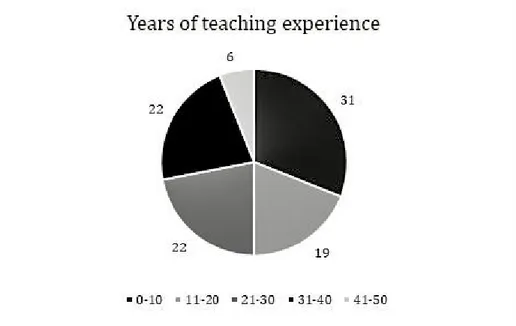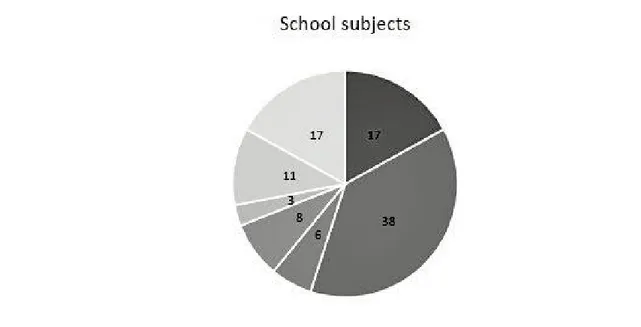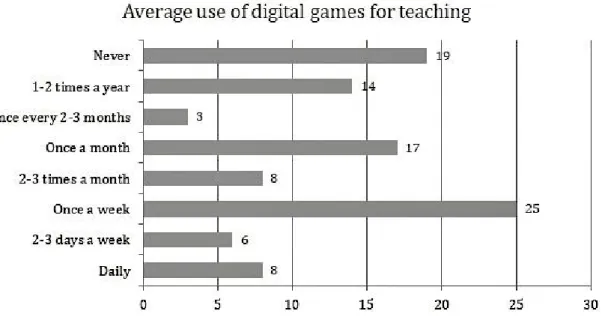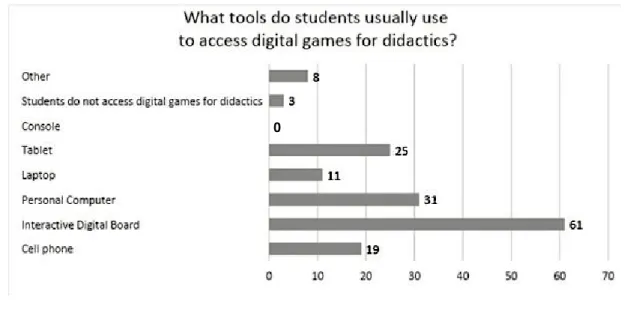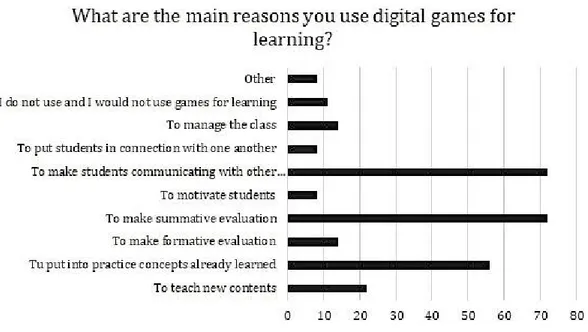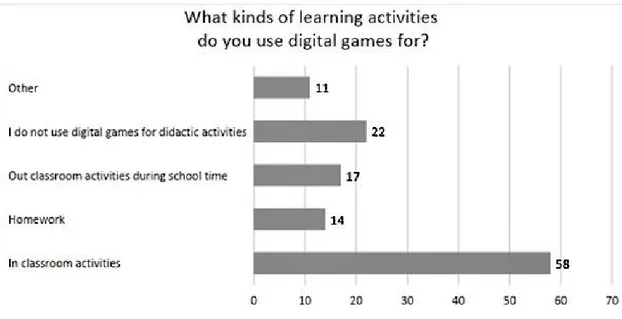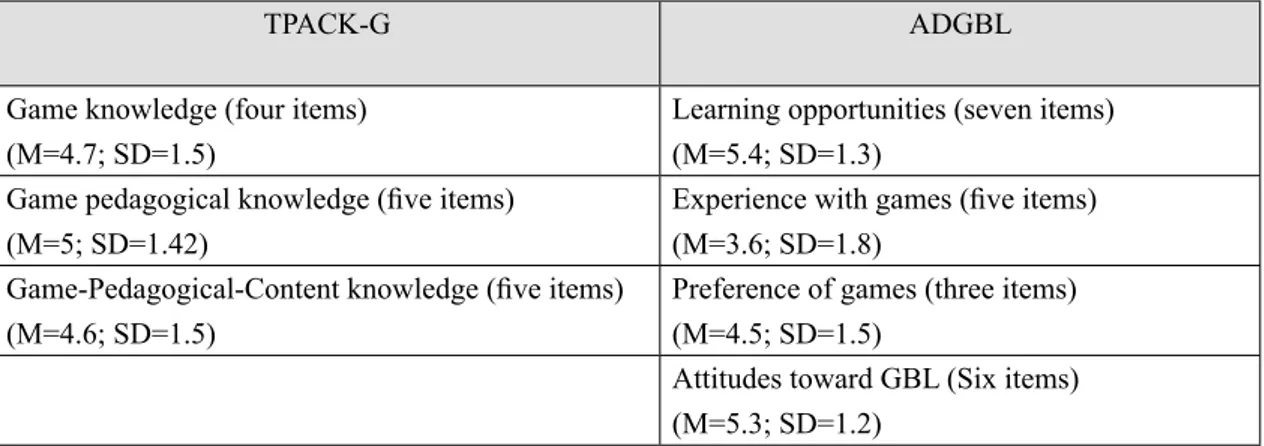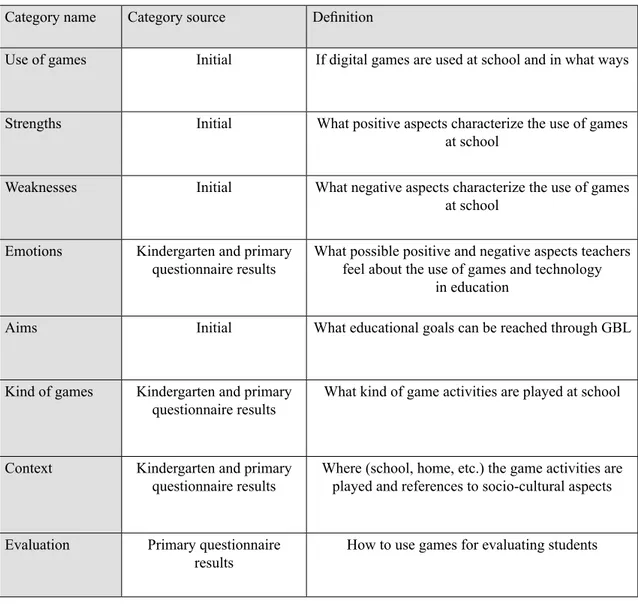To play or not to play? A case study of teachers’
confidence and perception with regard to digital
games at school
Gioco o non gioco? Uno studio di caso su percezione
e senso di sicurezza degli insegnanti rispetto all’uso
dei giochi digitali a scuola
Fedela Feldia Loperfido*, Anna Dipace and Alessia Scarinci
University of Foggia, Italy, [email protected], [email protected], [email protected] *corresponding author
HOW TO CITE Loperfido, F. F., Dipace, A, & Scarinci, A. (2019). To play or not to play? A case study of
teachers’ confidence and perception with regard to digital games at school. Italian Journal of Educational
Technology, 27(2), 121-138. doi: 10.17471/2499-4324/1062
AbSTRACT Teachers’ perception of the use of games for learning is a crucial aspect for the creation
of Game-Based Learning experiences. At the same time, solid research on this point is still lacking. For this reason, this study analyses the confidence, knowledge and attitudes of teachers in an Italian school in the context of the use of digital games in teaching activities. To this end, we administered both the TPACK-G and ADGBL questionnaires, and conducted two focus groups. Descriptive statistics were used to analyse the results of the questionnaires, and qualitative content analysis was used to analyse the focus group discussions. Results show that the teachers’ perception is characterised by several not necessarily interrelated aspects: they make sense of game-based learning by comparing it with traditional didactics; they usually organise teaching activities with games to reach traditional goals (e.g. summative evaluation, individual study, etc.); and finally, they seem to be in a transitionary phase during which games have not yet been internalised as a resource for innovation.
KEYWORDS Game-Based Learning (GBL); Digital Games; Teachers’ Perception; Teachers’ Attitudes;
Case Study.
SOMMARIO La percezione che gli insegnanti hanno rispetto all’uso dei giochi digitali per
l’apprendimento è un aspetto tanto importante quanto poco esplorato e al tempo stesso rilevante rispetto alla realizzazione di esperienze d’uso dei giochi nella didattica. Perciò, in questo articolo analizziamo la padronanza, la conoscenza e gli atteggiamenti che gli insegnanti di una scuola italiana hanno rispetto all’uso dei giochi digitali per l’insegnamento. Nello specifico, sono stati somministrati il questionario TPACK-G ed il questionario ADGBL, e sono stati realizzati due focus group. I questionari sono stati analizzati attraverso statistiche descrittive e i focus group attraverso analisi qualitativa del contenuto. I risultati mostrano che la percezione degli insegnanti è caratterizzata da diversi aspetti non
necessariamente integrati tra di loro e che gli insegnanti costruiscono il senso dei giochi digitali nel confronto con la didattica tradizionale. Infatti, solitamente organizzano attività mediate dai giochi per realizzare funzioni didattiche tradizionali (ad es. valutazione sommativa, studio individuale, ecc.). In altre parole, gli insegnanti sembrano essere in una fase di transizione in cui il gioco digitale non è ancora stato interiorizzato come risorsa per l’innovazione.
PAROLE CHIAVE Apprendimento Basato sui Giochi; Giochi Digitali; Percezioni degli Insegnanti;
Atteggiamenti degli Insegnanti; Studio di Caso.
1. STATE OF THE ART
In recent years, scientists, politicians and teachers have been paying increased attention to the use of games in education. Clark, Tanner-Smith and Killingsworth (2016) conducted a meta-analysis of the studies of digital games and learning for K-16 students showing significant learning benefits associated with the edu-cational use of games, especially when the games involved were enhanced with features designed to foster learning. At the same time, both national and European institutions are developing new policies, funds and initiatives to support the use of educational games. For example, a report published by European Schoolnet (Felicia, 2009) analyses the way games are used in eight European countries and provides suggestions for teachers who intend to design Game-Based Learning (GBL), on the assumption that computer games are productive tools for students, since they can teach them fundamental life skills. They can support the devel-opment of creativity, strategic and innovative thinking, and cooperation processes. McClarty et al. (2012) underline that the key prerequisites for effective digital games are the following: that they are created on solid learning ideas, engage learners strongly, give students the opportunity to personalise their learning ex-periences, foster the development of 21th century competences, and support authentic assessment of learn-ing. In the literature, the term Game-Based Learning (GBL) identifies the practice of using videogames to support teaching and learning (Kiili, 2005). From a pedagogical point of view, GBL can be regarded as «a
form of experiential engagement in which people learn by trial and error, by role-playing and by treating a certain topic not as content but as a set of rules, or a system of choices and consequences. In curricular terms, this means translating an element of a subject (such as a law of physics or the law of supply and demand) into the mechanics of a game, which operates within a self-contained system based on choices and consequences» (Perrotta, Featherstone, Aston, & Houghton, 2013, p. 7).
So, when learning through gaming activities, students are engaged in highly motivating and interactive experiences. According to this approach, in videogames two different levels of learning can be identified (Benassi, 2013). There is explicit learning, related to rules, values, codes, rites and procedures, narrative contexts, and the tools and options available in the game. There is also collateral learning, which is based on the development of skills useful for the successful playing of the game. The results of the explicit learning are usually strictly delimited in the virtual boundaries of the game, whereas the effects of the lateral and im-plicit learning go beyond the use of the game. The narrative nature of digital games for education is further stressed by Gee (2013), who suggests that in videogames there is an internal and an external grammar. In a nutshell, this semiotic view of digital games highlights the inner aspects of the game, such as rules, mechan-ics, characters’ roles, along with others. Beside these, there are external, surrounding aspects of the game, embracing, for example, the system of social relationships, cultural values, and discourses about the game itself. In some ways, these aspects characterize microcultures within which stakeholders exchange informa-tion, strategies, solutions, and so on. Therefore, players learn new concepts and vocabulary, new strategies of thinking and ways of seeing the world (Gee, 2004; Squire, Giovanetto, Devane, & Durga, 2005).
In line with Hamari and Nousiainen (2015), we posit that, in GBL processes, the perception, values and cultures that teachers embody with respect to games can be important components in shaping both the or-ganization and the efficacy of GBL processes. More generally, teachers’ use of technology has been studied from different perspectives, including the educational goals they pursue, and their attitudes and educational ideologies, just to mention a few. The topic has been investigated by focusing on the complexity of tech-nology, the level of acceptance of technology by teachers or through an ecological perspective. However, Hamari and Nousiainen (2015) also note that there is a lack of studies of teachers’ views on the use of dig-ital games, especially investigations that highlight and compare the perception of in-service teachers from different levels of the school system. To this end, Hsu et al. (2013) proposed two new questionnaires to ascertain both teachers’ confidence with games in education and their acceptance of digital GBL. Accord-ingly, they developed the Technological Pedagogical Content Knowledge-Games (TPACK-G) question-naire by looking at three different dimensions constituting teachers’ confidence in this area. They focused on teachers’ Game Knowledge (GK) (their confidence in the knowledge of how to use digital games; four items), Game Pedagogical Knowledge (GPK) (their confidence in the knowledge of how digital games can facilitate pedagogical approaches; four items), Game-Pedagogical-Content Knowledge (GPCK) (their confidence in their ability to support students’ learning of specific content by using appropriate digital ed-ucational games, five items). At the same time, Hsu et al. (2013) created the Acceptance of Digital Game-Based Learning (ADGBL) questionnaire to investigate the Learning Opportunities (LO) (the degree to which teachers believe that the use of educational games can give students learning opportunities; seven items), the preference for games (PFG) (the preference for using games in the classroom; three items), the experience teachers have with games (EWG) (five items) and teachers’ attitudes toward GBL (ATT) (six items). In this paper, we will analyse the perception of 36 teachers from several different levels (kindergar-ten, primary and middle school) in an Italian school. As for this, it is necessary to explain that, in Italy, there are individual comprehensive schools that comprise all three levels. The study triangulates data collected through the TPACK-G and ADGBL questionnaires with that emerging from two focus group discussions in order to understand teachers’ attitudes towards the use of games for learning.
2. THE AIMS
This study aims to understand teachers’ attitudes to and perceptions on the use of GBL in their daily teach-ing activity1. In particular, we aim to assess:
1) Teachers’ level of confidence in the use of digital games for education;
2) the level of acceptance those teachers have of the use of digital games at school; 3) how these teachers perceive the use of digital games at school from a deeper point of
view.
The aim of the study is exploratory and, in “The method” section, each phase of the study is described in relation to its aims and research methods.
3. THE CONTExT
The teachers involved in the reported research work at Santa Chiara School in Foggia2, a comprehensive
1 The research described in this paper is supported by the UniTutor – UniFG project. 2 Foggia is a small town located in the Northern Apulia region (South of Italy).
school comprising a kindergarten, a primary school and a middle school. In 2014, the school participated in Smart Future, a project using an innovative teaching model where «the teacher, through a tech solution
created by Samsung, can upload lesson content on tablets, share them with students, create group activi-ties, create quizzes and surveys to check the students’ understanding» (Rivoltella, 2015, p.47). In total, 60
teachers work at Santa Chiara and this school conducts several projects to update teaching practices and is a strong agent for change in the area of Foggia3.
4. THE METHOD
The study entailed two phases, each with different aims, tools and methods of data collection and analysis in order to assess teachers’ points of view on the use of digital games in education. The first phase aimed at investigating confidence and acceptance. The methods of data collection were the translated TPACK-G (a 7-point Likert scale, ranging from 1=Strongly disagree to 7=Strongly agree, composed of 17 items) and ADGBL (a 7-point Likert scale, ranging from 1=Strongly disagree to 7=Strongly agree composed of 21 items), both of which were administered to all the teachers. A team of four experts from the University of Foggia performed the translation: two of them first made a literal translation, then all four discussed the first translation and strove to perfect it by taking into account both English and Italian language cultures). Some demographic questions (sex, age, in-service seniority, level of school and school subject) and six closed questions were added to the original questionnaire. A Google Form was created and then circulated among the teachers, using both their WhatsApp group and their institutional e-mail addresses. Participation was voluntary. Descriptive statistics such as percentage distributions mean and standard deviation were run for each questionnaire item (described in the paragraph “State of the art”), i.e. Game-Knowledge; Game-Ped-agogical-Knowledge; Game-Pedagogical-Content Knowledge for the TPACK-G and, for the ADGBL, learning; preference for games; experience with games; attitudes towards GBL.
The second phase aimed at investigating teachers deep perceptions. To this end, two one-hour focus group discussions with semi-structured interviews (Casey & Krueger, 1994) were carried out. They explored the following themes: perception of educational digital games, strong and weak points of educational digital games, didactic aims and digital games, use of digital games at school (how, when and why they are used). The structure of the focus groups was defined by a four-expert team after analysing the results of the ques-tionnaires.
One focus group involved eight teachers from kindergarten, while the other one involved eight teachers from primary school. The teachers were selected by the school head and the deliberations of the two focus groups were audio recorded and transcribed. The method for focus group analysis was the qualitative con-tent analysis of transcripts (Potter & Levine-Donnerstein, 1999).
As for the analysis of the focus groups, an initial analysis grid was composed of four main headings (use of games, strengths, weak points, aims). Both focus groups were analysed by two independent research-ers, who started from the initial categories on the grid and added to them. As the analysis proceeded, the following categories were added: emotions, kinds of game, context, evaluation. Then the transcriptions were analysed again, keeping all the categories in mind. At the end, the two researchers compared the categorizations until they reached 100% agreement. In this method, the unit of analysis corresponds to the unit of meaning (Chi, 1997; Veldhuis-Diermanse, 2002); therefore, coders looked for individual themes, expressions of ideas, argument chains or discussion topics. After the categorization, descriptive statistics (percentages) were calculated and discourses were analysed qualitatively (Ligorio, Loperfido, & Sansone,
2013; Ritella, Martinelli, Loperfido, & Ligorio, 2015). For this last step, the same two researchers discussed together the content of the focus group discussion through the theoretical lens. Then they compared the contents in a team composed of them and other two four experts.
5. QuESTIONNAIRE RESuLTS
5.1. The participants
Due to the exploratory nature of our research, we first looked at descriptive statistics giving a snapshot of the sample and its characteristics. Out of the 60 teachers working at Santa Chiara School, 36 of them (5 M; 31 F) took part in the research. The average age of the teachers was 49 years and the average teaching experience was 20 years. As shown in Figure 1, we divided the teachers into five groups depending on their teaching experience (0-10 years, 11-20 years, 21-30 years, 31-40 years, 41-50 years). Most of the teachers (31%) have been teaching for 0-10 years and just 6% have taught for 41-50 years. Sixty-three percent of the teachers are in the 11-40 years group. This means that the participants in the research are relatively young professionals and, as the mean value would suggest, they are in the middle of a typical teaching professional’s career.
Figure 1. Breakdown of sample population by level of teaching experience (years accrued).
Most of the teachers (72%) work in Primary school, while 22% of them work in Middle school. Only a few teachers who work at kindergarten answered the questionnaire (6%) (Figure 2).
Figure 2. Breakdown of sample population by school level.
As for the school subjects taught, Figure 3 describes the distribution of the teachers by subject.
Figure 3. Breakdown of sample population by subject taught.
Most of the respondents teach Humanities.(38%), followed by Sciences (17%) and other fields (17%). The smallest number of respondents was represented by teachers of Religious Education (3%). However, the sam-ple comprised teachers of all the different subjects taught in the school (even if some are in small numbers).
6. OuTCOMES
Besides the above demographic data, we asked the teachers six questions aiming to get a better understand-ing of how digital games are used by the interviewees. The first of these questions was: “On average, how often do you use digital games for teaching?”. Figure 4 shows the percentage distributions of their answers.
Figure 4. Participants’ average use of digital games for teaching.
While 39% of respondents use games for teaching at least once a week, 42% of them use them 2-3 times per month or less and 19% never use games. Thus, the educational use of games is not very frequent among respondents. Furthermore, even though, generally speaking, 64% of the teachers (which is the sum of those using the digital games daily, 2-3 days a week, once a week, 2-3 times a month and once a month) support teaching and learning processes through the use of digital games, a large proportion of the participants never uses them for education, at least to date (19%).
The rest of the questions deal with the way in which the teachers learnt how to use digital games for educa-tion. To these, teachers could choose more than one answer. In order to underline important findings about teachers’ perceptions, some percentages are added in the discussion of the findings. However, it should be borne in mind that the categories explored through the following questions are not mutually exclusive. Figure 5 shows that 25% of the teachers learnt how to use digital games during their training. This figure, when summed with those pertaining to hetero directed learning (from students and from colleagues), totals 47%. Self-directed learning experiences add up to 28%, which means that, probably, the teachers looked for resources that teach them to use digital games outside the circle of students and colleagues. The data relating to online resources used for this purpose (45% of teachers use them) is unreliable, insofar as the questionnaire does not discriminate between the kind of resources teachers used. At the same time, the label “Other” is represented by 6% of the teachers and does not single out the other solutions teachers use, which could be the subject of further research. Another important finding is the low percentage of teachers not using digital games for teaching at all (3%). This is interesting not only because only a small number of teachers does not use digital games, but rather because they declare that they do not know how to use
them. Therefore, it seems that teachers perceive they do not possess the right or appropriate knowledge to integrate digital games into their teaching activities.
Figure 5. Methods participants adopted to learn how to use digital games for teaching.
When the participants were asked what kind tools they believe students usually employ to access digital games for learning purposes, they answered as shown in Figure 6.
Figure 6. Participants’ estimation of tools students usually employ to access games for learning purposes.
Discounting the general data for students not accessing digital games for learning purposes and the students using other tools besides those listed in the questionnaire (a total of 11% of students in the teachers’ estima-tion), we clustered the tools into two groups. The first one is mobile tools (tablet, laptop, cell phone), which
represents 55% of the students; the second one contains largely fixed instruments (PC, Interactive Digital Board and console), which are used by 92% of the students. In this regard, it is interesting to observe that, in the teachers’ perception, students do not use any kind of console. However, the AESVI Association (2018) recently published research into the use of digital games and consoles in Italy. According to the study, the growth in console use in 2018 was from 47 to 49%. The research does not detail the age of the gamers and the type of games they play. However, we find it interesting that, with this increasing use of consoles, stu-dents do not use any of them for learning. Probably, there is a gap between the perception teachers have of the students’ use of consoles and their real use. Moreover, teachers may also harbour the implicit idea that students cannot learn any skills by using these tools.
The teachers were asked three further questions to explore their habits regarding GBL. The first was: “What are the main reasons for using digital games for learning?” (Figure 7).
Figure 7. Reasons participants use digital games for learning.
The most common uses of digital games for learning have to do with communication among students and summative evaluation. Furthermore, 56% of the respondents use games to help students put into practice the concepts they have already learnt. Another interesting result is that the teachers use games to teach new contents (22%), to manage their classes (14%) or for formative evaluation purposes (14%). In relation to this question, we also asked the teachers how they arrange activities when they use GBL (Figure 8).
Figure 8. Type of learning activities in which participants use digital games.
58% of the teachers organize in-classroom activities with digital games. Mediated learning activities are carried out in out-of-classroom spaces (17%) and at home (14%) as well. Finally, the teachers were asked how they usually arrange students for GBL activities.
Figure 9. Participants’ arrangement of students for digital game use.
Thirty-three percent of the teachers organize students in pairs and 28% ask them to work by themselves; the remaining 25% organize activities between classrooms as well (Figure 9).
and standard deviation for the factors measured through the two TPACK-G and ADGBL questionnaires described above (see Section 1. “State of the art”). Table 1 shows the results for each factor listed in the questionnaires.
TPACK-G ADGBL
Game knowledge (four items) (M=4.7; SD=1.5)
Learning opportunities (seven items) (M=5.4; SD=1.3)
Game pedagogical knowledge (five items) (M=5; SD=1.42)
Experience with games (five items) (M=3.6; SD=1.8)
Game-Pedagogical-Content knowledge (five items) (M=4.6; SD=1.5)
Preference of games (three items) (M=4.5; SD=1.5)
Attitudes toward GBL (Six items) (M=5.3; SD=1.2)
Table 1. Descriptive statistics about the factors measured by each questionnaire.
These results show that, generally, the teachers’ responses pitch at a score between 4.6 and 5 on the 7-point TPACK-G Likert scale. At the same time, they translate into a score between 4.6 and 5 on the 7-point ADGBL Likert scale. These results show that teachers do not feel very competent in the use of games in education. At the same time, they see potential for their use at school. However, the more detailed results for these two different macro dimensions (confidence about games measured through the TPACK-G scale and the level of acceptance of games measured through the AGDBL scale) reveal that teachers have, on average, greater confidence in their knowledge about how digital games can facilitate pedagogical activities than the knowledge they have of games and methods to support their students in learning specific content using appropriate digital educational games. It seems that teachers grasp the importance and effectiveness of the connection between the use of games and successful learning, but that they do not yet know what tools, strategies and specific approaches are required to choose the right game for a given teaching experi-ence. Furthermore, they do not really know how to support the learning of specific content with appropriate games. For example, when asked if they can craft learning activities addressing real world problems around content knowledge and represent them through digital games to engage their students (item GPCK3), the teachers responded between “slightly disagree” and “neither agree nor disagree” (the 3.9 point on the Likert scale). At the same time, on average, their response on knowing how to use digital games to support teach-ing (item GPK5) reaches the 2.3 point on the Likert scale (“slightly disagree”). The results on the ADGBL scale seem to align with the above conclusions. Indeed, it seems that teachers think, on average, that digital games can provide numerous opportunities for teaching and learning (e.g. to control the learning process, to stimulate transfer between various subjects, to train the learners in critical thinking among other things). In particular, they agree (a 6 score on the Likert scale) that “Digital games offer opportunities to motivate stu-dents” (item LO5) and that “Game-based learning can enhance students’ learning motivation” (item ATT4). Therefore, on average they have positive attitudes toward games and their power to motivate; however, it seems that their experience of games used for educational purposes is quite limited and they are cautious about frequent use of digital games for learning (3.3 on the Likert scale) (item EWG4).
7. THE FOCuS GROuP RESuLTS
After analysing the results of the questionnaires, we arranged two focus group discussions, one consisting of eight female kindergarten teachers and the other composed of eight primary school teachers (7F; 1M). As already explained, in order to analyse the discussions, we first defined some initial categories based on the results of the questionnaire and on the literature. These categories were enriched by the analysis itself, as we needed to add new ones to take account of the content emerging from the recorded texts. In Table 2, we set out the categories used and their definitions. Column 2 indicates the source, distinguishing between those defined initially and those added later on, showing from which focus group the additional categories emerged.
Category name Category source Definition
Use of games Initial If digital games are used at school and in what ways
Strengths Initial What positive aspects characterize the use of games
at school
Weaknesses Initial What negative aspects characterize the use of games
at school
Emotions Kindergarten and primary
questionnaire results What possible positive and negative aspects teachers feel about the use of games and technology in education
Aims Initial What educational goals can be reached through GBL
Kind of games Kindergarten and primary
questionnaire results What kind of game activities are played at school
Context Kindergarten and primary
questionnaire results Where (school, home, etc.) the game activities are played and references to socio-cultural aspects Evaluation Primary questionnaire
results How to use games for evaluating students
Table 2. Initial and additional categories for interpreting focus group outcomes.
Two main considerations emerged from the focus groups:
1) teachers’ comments on digital educational games imply both positive and negative assessments. The need to identify the kind of games which might be used is one
con-cern of teachers, and reference to context represents another. As regards this last point, teachers’ interest is in both the physical space where games are played and the broad cultural context surrounding those activities;
2) it seems that teachers from primary school are more concerned about evaluation pro-cesses; therefore, the weight they give to learning and, in turn, to the use of educational games is more bound up with their students’ performances. More specifically, by look-ing at each focus group, we can go in-depth and examine the main percentages for each category, performing qualitative interpretation of the representative excerpts.
In the following two sections, we will analyse in depth each focus group discussion.
7.1. The kindergarten focus group
7.1.1. Strengths and weaknesses
In the kindergarten focus group, the category with the highest percentage is “Weaknesses” (26%) of digital games, whereas the category “Strengths” (7%) has the lowest percentage. For example, teachers affirm: “You cannot leave children alone with those tools” or “Usually, mums leave children alone in front of games, there is no information about games for educational purposes” and “There is little sociability in children who are overexposed to technology”. It seems that such negative aspects of games and, in general, of technology are about two main components: the logistical and the interpersonal aspects.
At the organizational level, indeed, teachers assert that children should be supervised when they play digital games and often this is difficult given the high number of students in the classroom. At the interpersonal level, two aspects emerge, which have to do with the children’s development and the teacher-parent-child relationship. Indeed, teachers say that, when students use technology too much, their socialization is hin-dered and it seems they feel the need to counterbalance the parents’ educational style (if children play so many digital games at home, it is better if they do not do so also at school).
It seems that teachers perceive digital games and technology as something potentially dangerous which implies the inescapable direct mediation of an adult. On the other hand, some strengths are perceived: teachers believe that games and new technology “are a good opportunity, because children participate actively, especially in games requiring logic. Many pupils have made progress” and “with the Interactive Multimedia Board you can see images, have more information. You can learn”. In other words, it seems that the dominant impression that the teachers have formed of digital games is that of unfamiliar and dangerous tools. However, at the same time, the opposite point of view also emerged in the interviewed group, namely recognizing games’ potential for presenting learning content and supporting key skills like participation. In some ways, it seems that, by stressing both the weaknesses and the strengths of games, teachers (re)express both apocalyptic and integrated perspectives (Eco, 2011). The first view sees the devil in digital learning games, whereas the second sees them as an integral part of society and daily life.
7.1.2. Use of games
The way games are used is another category with a high relative incidence (23%). This issue is mostly addressed by comparing traditional games with digital ones. In some ways, it seems that teachers need to refer to the characteristics of non-digital activities to define those of the new digital tools for education. As one teacher says, “We have had Interactive Multimedia Boards for two months. They enable you to carry out activities that you can only do with the teacher’s help. Their use is limited”. Another refers to traditional games: “A series of games built all together is created; their purpose is to make everyone participate and to hold the students’ attention”. The idea that technology requires the support of an adult recurs and seems
to be less reassuring for teachers comparing their confidence with technology to the sturdy command they have of traditional games.
7.1.3. Aims
Another concern emerging several times relates to the effectiveness of technology in sustaining the devel-opment of children’s interpersonal skills (in this case, the explicit reference is to the value of traditional games for engendering participation). The categories encompassing these considerations are “Aims” (14%) and “Kind of games” (12%). As for the goals of using games, teachers say that they “can improve memory” and “allow children to relate to each other”. Another comment was as follows: “A goal was to demonstrate to a child, whose parents had said that the blowfish does not exist, that it does indeed exist, and that research has been carried out, which has expanded to the hammerhead”. Another goal would be “to educate children on the correct use of technology and digital games”. Therefore, it seems that a variety of objectives can be achieved through digital games. Those range from aspects of cognitive development (developing mne-monic abilities), interpersonal development (learning to relate to each other) and conceptual development (learning new concepts and how to investigate them).
7.1.3. Kind of games
The category “Kind of games” (12%) explains what type of games teachers choose for their activities. For example, when talking about environments for logic games, it is noted that “on the computer you can show art, tell stories, draw”.
7.1.4. Emotions
Two more categories emerge from the discourse, which are “Emotions” (9%) and Context (9%). As for the emotions category (9%), teachers say that when children are left alone with digital games “they become boisterous”, but also that “they really have fun when we use them” and “they are enthusiastic”. The emo-tions that are unleashed in children seem to be one of the reasons why teachers feel they need to manage and control digital educational activities.
7.1.5. Context
Finally, as we have already mentioned, the context category refers to two levels: the logistical aspects and the broader cultural environment. Here teachers specify the tools they can use where they work. One has her own tablet to play digital games, whereas others say: “We have only one Interactive Multimedia Board and we have to share it”. By way of contrast, some teachers paint a different picture: “Many years ago, when the popularization of technology started at school, both teachers and students had to take part in many lab sessions. Therefore, the new digital literacy was taught at school. Nowadays, however, paediatricians demonize the use of videogames or computers, because they might be the cause of epileptic seizures in children who are over exposed to such devices. In any case, students do not need to learn how to use them anymore because they already know how to do that”.
7.2. The primary school focus group
In the primary school focus group discussion, the category with the highest percentage is “Use of games” (24%), followed by the “Context” (19%) and “Aims” (17%) categories. Teachers seem to be most con-cerned with the practical aspects of using games, the environment in which to use them and the goals to reach through games. In particular, in this group interview, the relationship between digital and traditional games emerges once more. However, a strong contrast between these two types of games is not expressed.
Rather, they are perceived as two different educational strands that can be woven together.
7.2.1. Use of games
The teachers say that they use gaming with the older children (9-10 years old) through exercises on subject area content. Furthermore, “this can be the introductory step into a new learning activity,” again through the mediation of digital games and platforms. One teacher says: “Last year I used them a lot. There were tablets available, which the children used”. This use of games is often associated with the activities of students with special educational needs; but, even so, the idea of counterbalancing home habits that are perceived by teachers as exaggerated arises from this focus group, too (“With children who had different educational needs I avoided using them because they are already used too much at home”). From these excerpts it emerges that teachers perceive the use of digital games and technology as tools to be blended with traditional face-to-face education. This integration implies the availability of tools (the use of tablets or PCs), space-time organisation (the beginning of a new learning activity) and the targeting of delivery (9-10 year-old children, children with special educational needs, children who do not use digital games too much at home).
7.2.1. Context and Aims
This design of GBL activities can be better understood by exploring in depth both the “Context” and “Aims” categories. The first category yields excerpts like: “The classrooms do not have PCs” and “very often there is no Internet connection. Last year we went to the computer lab”. Comments centre, therefore, mainly on the limited means of the school and its equipment. However, examining the category “Aims”, we can see that teachers display an awareness that these days “we cannot ignore digital natives and the need to use digital games”. Even though we are not primarily concerned with comparing outcomes from the kindergarten and primary focus groups, we nevertheless wish to underline the salient features of this group interview. The accent seems not to be on the dangerous effects that digital games might have, but on the nature of contemporary students. In turn, there is the idea that school has to lead social changes and educate students about them.
7.2.2. Weaknesses and Strengths
The dimension “Weaknesses” (10%) would appear to echo aspects of Context, as well. Indeed, the teachers say that they have no real digital games at school. Rather, they have Interactive Multimedia Boards that they cannot use whenever they want. In contrast to this, teachers talk about the virtues of digital games or technology for education. “Digital games are very useful […] children really pay attention when we use
them”. Some teachers stress another weakness: “When children are left in front of the computer for three or four hours every day, they have difficulty expressing themselves and they isolate themselves,” but they
re-iterate some of the issues raised in the “Emotions” category (10%).
7.2.3. Emotions and Kind of games
“When we used the board, children had fun”; “The students like the board and games a lot, they are moti-vated, they are really attracted by them”. Furthermore, one teacher affirms: “When I see children playing a new game, I play with them too and then we discuss it”. Therefore, teachers try to keep up with educational advances to sustain the development of their children’s key skills, even to the extent of making good the lack of technology at school. Indeed, they say that sometimes they bring their own devices to school to use those games and digital environments mentioned in the “Kind of games” category (8%). “I use Paint and games on some websites”, “I use the games that you can easily find online”, two teachers say.
7.2.4. Evaluation
The last category we used in our analysis of this discussion is “Evaluation” (4%). The frequency of this item is not so high; however, this is a distinctive dimension of the primary school focus group. They say that learning is assessed through the playing of the game: “For example, if we play a digital game, we observe the child’s behaviour in relation to the game. We observe that she may be alone or in a group. Very often we use informal cooperative learning when the evaluation is on the management of the group, the way the group worked and its characteristics”. Teachers also say that gaming creates some dynamics among students that a question or a written task cannot. In this sense, the importance of developing the pupils’ key skills is confirmed again, and the opportunity to use both digital and traditional games for this purpose represents an attempt at innovative teaching.
8. CONCLuSIONS AND FuTuRE DIRECTIONS
In this paper, we have analysed how teachers working at a comprehensive school composed of a kinder-garten, a primary school and a middle school perceive the use of digital games in education. The general goal was to understand the teachers’ perception of GBL in the specific context we have analysed here. To explore this aspect, we merged the results of both TPACK-G and ADGBL questionnaires with those of two focus groups.
To summarise the findings, a very complex perception of digital games arises from the teachers participat-ing in the research study, reflectparticipat-ing the reciprocal interaction of several factors. For example, games are used for different reasons: for collaborative and individual activities; for the development of the individual and the group; for content learning and the development of key skills; for general and progress assessments; for putting into practice concepts already learnt as well as teaching new content; for motivating students; and for facilitating effective class management.
However, it seems that, very often, these functions of educational games are not reciprocally integrated but rather struggle with one another. Speaking about the teachers’ confidence about the use of games and their level of acceptance of digital games at school, for example, it emerges that participants broadly agree with the idea of using games especially for motivating pupils. However, they do not know strategies and meth-ods to use games in an efficient way. In some ways, teachers seem to be at a stage in the use of technology during which the tool is not yet internalised and, to better understand it, they need to associate digital games with the traditional activities they already know. It seems that long-established practices act as a benchmark to give meaning to the new digital experiences. At the same time, the teachers do not really know the digital environments and cannot handle them. Sometimes this stimulates negative emotions. All of these aspects are intricately linked with other factors such as the interaction between family cultures, the school and people inside the school, and a broader context, the need to define a new role for adults in those different arenas. When we look at the two focus group discussions, the image that teachers have of digital games is quite different: a risky source of trouble for the kindergarten school teachers and a possible springboard to development for the primary school teachers. These differences are not so evident, but it does seem that, to an extent, the bulk of the teachers in the sample tend to polarise towards either the apocalyptic or integrated ends of the spectrum (Eco, 2011). However, what can the school do to help shift teachers towards a more complete integration of digital games in the teaching process in such a way as to sustain their students’ mo-tivation? Probably, as similarly suggested by Persico et al. (2017), a programme of continuous in-service training can help teachers learn what kind of games exist, how they can be used for pedagogical purposes, and what pedagogical models can sustain teaching and learning.
This research initiative represents a case study describing the perceptions of a sample of teachers working in a specific Italian school and some interesting results have certainly emerged from the study. Neverthe-less, future research priorities can be identified and some of them are in fact already ongoing. This study only takes into account the teachers’ perspective, so running the risk of portraying education primarily as a top-down process. Therefore, a study of learners’ perceptions of GBL, and on the way both teachers and learners build their own game-based learning experience interactively could complement this first step of our research.
In the original research by Hsu et al. (2013), a factorial analysis was run to compute the reliability of the factors considered and several ANOVA tests were conducted. Given the aims of our paper and the small number of participants in the research, we could not run such an analysis, since it would not have been statistically significant. Therefore, we are working on a new study to overcome this limitation and increase the sample of teachers involved across other schools and contexts, and to structure validated questionnaires measuring both teachers’ confidence and acceptance of digital games in the context of Italian culture. As for the focus group discussions, a third focus group involving middle-school teachers is missing. Our original intention at the outset of the study was to interview a group of teachers from each level of comprehensive school. However, organizational restraints within the school prevented middle school teachers from taking part at that stage. They will, however, be involved in future research activities.
9. AKNOWLEDGMENTS
We would like to express our gratitude to the Santa Chiara School and to the teachers involved in the re-search for their valuable participation. We are also immensely grateful to Adriana Di Biase and Loredana Buscemi for their proofreading and review during the drafting process.
This article has been developed jointly by the authors. More specifically: Alessia Scarinci wrote the sec-tions 1. State of the art, 2. The aims, 3. The context, Anna Dipace wrote the secsec-tions 4. The method, 5. Ques-tionnaire results, and Fedela Feldia Loperfido wrote the sections 6. The focus group results, 7. Conclusions.
10. REFERENCES
AESVI (2018). Primo rapporto sugli esports in Italia. Retrieved from http://www.aesvi.it/cms/view.php?dir_pk=902&cms_pk=2919
Benassi, A. (2013). Videogames and collateral learning. Italian Journal of Educational Technology, 21(3), 141-144.
Casey, M. A., & Krueger, R. A. (1994). Focus group interviewing. In Measurement of food preference (pp. 77-96). Boston, MA, USA: Springer.
Chi, M. T. (1997). Quantifying qualitative analyses of verbal data: A practical guide. The Journal of the
Learning Sciences, 6(3), 271-315.
Clark, D. B., Tanner-Smith, E. E., & Killingsworth, S. S. (2016). Digital games, design, and learning: A systematic review and meta-analysis. Review of Educational Research, 86(1), 79-122.
Eco, U. (2011). Apocalittici e integrati: comunicazioni di massa e teorie della cultura di massa. Firenze, IT: Giunti.
Felicia, P. (2009). Digital games in schools. A handbook for teachers. Brusséls, BE: European Schoolnet. Retrieved from http://games.eun.org/upload/gis_handbook_en.pdf
Gee, J. P. (2004). Situated language and learning: A critique of traditional schooling. New York, NY, USA: Routledge.
Gee, J. P. (2013). Come un videogioco. Insegnare e apprendere nella scuola digitale. Milano, IT: Raffaello Cortina Editore.
Hamari, J., & Nousiainen, T. (2015, January). Why do teachers use game-based learning technologies? The role of individual and institutional ICT readiness. In System Sciences (HICSS), 2015 48th Hawaii
International Conference (pp. 682-691). IEEE.
Hsu, C. Y., Liang, J. C., Chai, C. S., & Tsai, C. C. (2013). Exploring preschool teachers’ technological pedagogical content knowledge of educational games. Journal of Educational Computing Research,
49(4), 461-479.
Kiili, K. (2005). Digital game-based learning: Towards an experiential gaming model. The Internet and
Higher Education, 8(1), 13-24.
Ligorio, M. B., Loperfido, F. F., & Sansone, N. (2013). Dialogical positions as a method of
understanding identity trajectories in a collaborative blended university course. International Journal
of Computer Supported Collaborative Learning, 8(3), 351-367.
McClarty, K. L., Orr, A., Frey, P. M., Dolan, R. P., Vassileva, V., & McVay, A. (2012). A literature review of gaming in education [Research Report]. Gaming in Education, 1-35.
Perrotta, C., Featherstone, G., Aston, H., & Houghton, E. (2013). Game-based learning: latest evidence
and future directions (NFER Research Programme: Innovation in Education). Slough, UK: NFER.
Persico, D., Dagnino, F., Earp, J., Manganello, F., Passarelli, M., Pozzi, F.,..., Bailey, C. (2017). Report
on interviews with experts and informants. Gaming Horizons Deliverable D2.3. Retrieved from https://
www.gaminghorizons.eu/deliverables/
Potter, W. J., & Levine-Donnerstein, D. (1999). Rethinking validity and reliability in content analysis.
Journal of Applied Communication Research, 27(3), 258 – 284.
Ritella, G., Martinelli, M., Loperfido, F. F., & Ligorio, M. B. (2015). Tecnologie (in)visibili: appropriazione in un percorso di training professionale. Italian Journal of Educational Technology,
23(1),19-25.
Rivoltella, P. C. (2015). Smart future. Teaching, digital media and inclusion: Teaching, digital media
and inclusion. Milano, IT: FrancoAngeli.
Squire, K., Giovanetto, L, Devane, B., & Durga, S. (2005). From users to designers: Building a self-organizing game-based learning environment. TechTrends, 49(5), 34-42.
Veldhuis-Diermanse, A. E. (2002). CSCLearning? participation, learning, activities and knowledge
construction in computer-supported collaborative learning in higher education.
